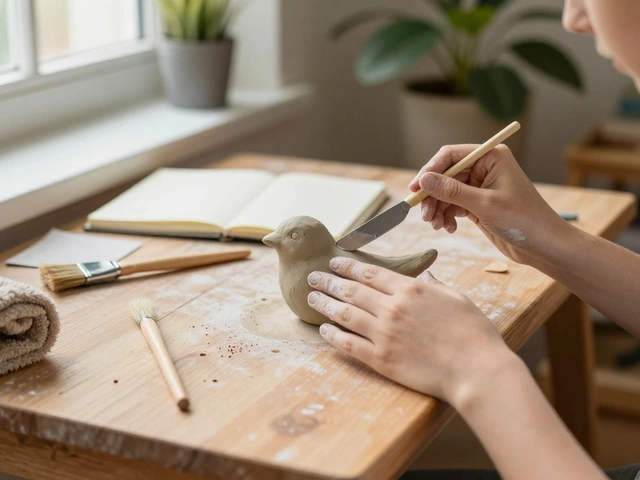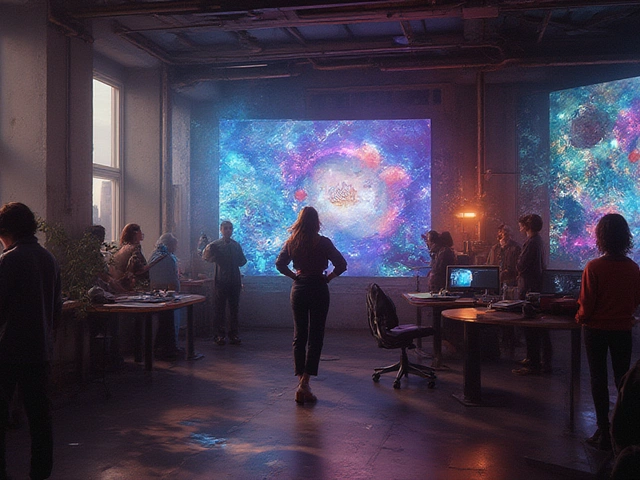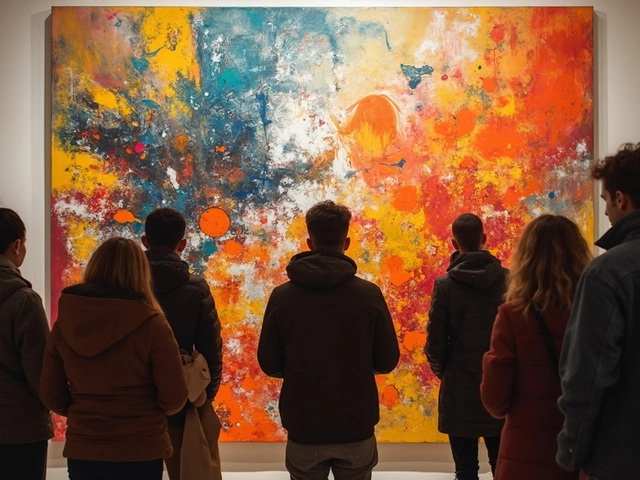Imagine walking through a city square and stumbling upon a massive bronze figure that feels alive, even though it's cold metal. That's the magic of sculpture—art that doesn't just sit quietly on a wall but claims space, demands attention, and leaves you with questions you didn't know you had. Sculptors dream with their hands, and the marks they leave shape how we experience everything from ancient myth to modern protest. But who are the artists behind these jaw-dropping works? You might know some names already (Michelangelo, anyone?), but the world of sculpture is full of surprises—stories of wild obsession, heartbreak, and relentless craft that make you see stone, metal, or even glass in a whole new light.
Legends of Stone and Bronze: Iconic Sculptors in History
When people think about the giants of sculpture, a few names echo across centuries. Michelangelo Buonarroti stands pretty much at the top, the guy who, against his own wishes, got pulled from painting the Sistine Chapel ceiling to chip away at blocks of marble. His "David"—that towering, perfectly muscled hero in Florence—was carved between 1501 and 1504, out of a single chunk of stone left over from another artist's failed attempt. We often forget that Michelangelo wasn’t just a painter or a sculptor; he was kind of a rock star in his day. Crowds gathered just to watch him work, dust flying everywhere. He called sculpture the "art of taking away"—removing everything that wasn’t David until the man himself seemed to emerge fully formed, veins, muscles, nerves and all.
But it’s not just Italians hogging the spotlight. Look back even further to Classical Greece. Phidias, the mastermind behind those marble gods and goddesses, shaped works that defined the very word "statue." Remember the massive Zeus at Olympia, one of the seven wonders of the ancient world? That was Phidias, handing the world its first true lesson in scale—proving art could be bigger than life.
Fast forward centuries and you run into Auguste Rodin, whose "The Thinker" set off a whole new way of looking at emotion in sculpture. Instead of smooth perfection, Rodin’s pieces sizzle with energy. His surfaces are rough, almost messy. You can see finger marks, sometimes intentionally left so you remember the human behind the hammer and chisel. Some critics hated his style, arguing real art should look finished and polished, but Rodin’s work has stuck around. You’ll find "The Thinker" and "The Kiss" from Paris to Philadelphia, and each copy somehow manages to feel like it’s thinking right back at you.
Of course, there’s also the spellbinding Louise Bourgeois, who built enormous spiders out of steel and marble. Her "Maman" stands over thirty feet tall—incredible, intimidating, and oddly maternal. Bourgeois often spoke about art as a language for dealing with memories and pain. Each leg, each knot of metal, is a piece of her family’s story. And by the time her work started to go truly global, she was already in her eighties, smashing boundaries that said sculpture was a man’s world.
Styles and Materials: The Many Faces of Sculpture
Sculpture never stands still, literally or figuratively. The art form has always been about more than just representing a person or an object. If you break it down, sculpture’s story is one of constant reinvention. That’s why, even though bronze and marble get lots of the attention, great sculptors experiment with everything from wood and clay to glass, found objects, and even sound. Ancient Egyptians carved hieroglyphs and statues out of limestone that lasted thousands of years. Their hidden tombs and sphinxes weren't just decoration—they told stories, honored the dead, and warned off trespassers. You can even touch centuries-old tool marks if you visit these sites today.
During the Renaissance, artists were obsessed with pushing material to its physical limits. Marble, for example, is not an easy medium. Not only is it heavy, but also one wrong whack and the whole thing shatters. Michelangelo supposedly claimed he "freed the figure from the stone," which sounds like something out of a myth, but if you look closely, you’ll notice how his chisel marks seem to follow the muscle and sinew under the skin.
Modern sculptors throw all the rules out the window. Constantin Brâncuși carved smooth, abstract forms meant to capture the essence of flight or the idea of a kiss, instead of a literal image. His "Bird in Space" is basically a gleaming sliver of bronze, but if you watch people walking around it, everyone finds themselves tilting their heads, searching for meaning. Picasso got in on the act too, building faces out of bicycle seats and handles—or welding together scrap metal just to see how the shadows would play.
It doesn’t end with traditional materials. Artists today work with plastics, recycled trash, neon lights, or even living moss. Think of Jeff Koons, whose shiny, balloon-shaped animals look like they belong at a kid’s party, but cost millions and are crafted from stainless steel and mirror-polished to high-gloss perfection. Some folks find his stuff kitschy or over-the-top; others see a wink at pop culture and childhood nostalgia. So when someone asks, "What is sculpture made from?"—well, the answer is just about anything an artist can dream up.
Famous Works That Changed the Sculpture Game
Certain sculptures don’t just sit there—they define an era or spark debate that spills out of museums and into the streets. The Statue of Liberty comes to mind. Designed by French sculptor Frédéric Auguste Bartholdi, it was assembled on what is now Liberty Island in New York Harbor back in 1886. Tens of millions have seen it and, for years, "Liberty Enlightening the World" has served as an icon for freedom and hope for immigrants arriving by boat. The statue itself was a feat of engineering brilliance: Gustave Eiffel (yes, that Eiffel) designed the internal framework to hold the weight of all that copper.
Move to contemporary times, and you can’t ignore Antony Gormley’s "Angel of the North," a steel behemoth with outstretched wings towering 20 meters high in northern England. Originally, locals were skeptical—why put a rusted angel in their backyard? These days, it’s a beloved landmark, woven into the identity of the region. Then there’s Maya Lin, who shocked critics by designing the Vietnam Veterans Memorial in Washington, D.C., with nothing more than a wall of black granite, carved with names. No heroes on horseback or dramatic scenes—just two long arms reaching into the earth, inviting quiet reflection. The simplicity ended up more powerful than any grand monument could have hoped.
Urban art brings sculpture down from the lofty pedestals, dropping it straight into public life. Think of "Cloud Gate"—more affectionately called “The Bean”—by Anish Kapoor in Chicago. The 110-ton, stainless-steel sculpture doesn’t just reflect the sky; it brings together skyline, clouds, and bewildered visitors, all in real time. Kids run under it, tourists snap endless selfies, and somehow the whole city becomes part of the artwork. Suddenly, everyone’s imagination comes into play, inviting questions rather than answering them.
Finding Your Own Favorite: Tips for Enjoying Sculpture
Sculpture isn’t just for scholars or museum-goers—it’s for everyone. You don’t have to know all the history or technical jargon to experience the thrill. The next time you spot a statue, public artwork, or unexpected installation, try to get as close as possible (without setting off any alarms). Notice the small details: Are there finger marks, tool grooves, or hidden symbols? Some artists, like Henry Moore, designed their works for the outdoors, letting weather and light sculpt along with them. His reclining figures look completely different from one season to the next.
If you’re in a city with outdoor sculptures, check if there are walking tours or maps. Sometimes the most famous pieces aren’t inside at all. Vancouver, for example, where I live with Althea, is full of unexpected art popping up in downtown squares, parks, or right outside coffee shops. You don’t need a ticket or invitation—just a willingness to look. Public art galleries often let you get close, and guided tours can fill in behind-the-scenes stories that bring these massive objects down to a human scale.
If you want to learn more about a particular artist, start with the basics: What are they best known for? What materials do they use? Why do people admire or argue about their work? There’s nothing wrong with googling or checking out a documentary. Even better, grab a friend and talk through your reactions. The awkward silence some folks feel in front of art disappears once you put your thoughts into words. Some galleries even have touchable replicas—perfect for understanding texture and shape with your own hands.
And if you get inspired (it happens!), try a community art class or a DIY sculpture project. It doesn’t matter if your first try is a lopsided clay mug or a wire figure. You’ll never look at a famous masterpiece in quite the same way again. The best way to appreciate sculpture is to make something yourself—even if it’s just a wobbly stack of pebbles in the backyard.






